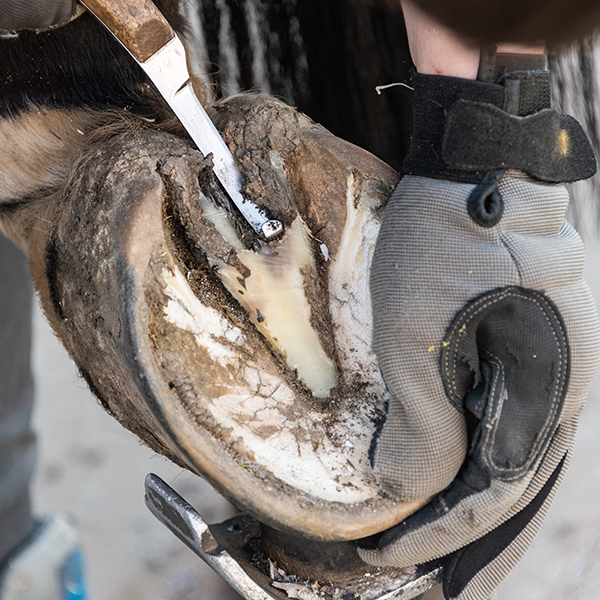Dry weather, rain and mud, and humidity, combined with stomping to deter flies can take a toll on your horse’s hooves this summer. Here in the Mid-South, most equestrians are gearing up for spring and summer shows, events, and trail rides, but we need well-maintained hooves in order to compete and show. “No hooves, no horse,” right?
Since hooves tend to grow faster in the summer, keep your horse on a regular schedule with the farrier. Regular trimming and shoeing will ensure your horse is comfortable and its hooves are in good condition. As a general rule of thumb, most horses do well on a four to six week trimming schedule throughout the summer; however, this will depend on your horse, the terrain it lives on, and your discipline of riding. Show horses may need to see the farrier at shorter intervals.
Like everything else that dries out in hot weather, horses’ hooves do too. Just like human hair and nails, horses’ hooves are made of keratin, a living tissue, and will be affected by the drying heat this summer. Brittle hoof walls, dried out by environmental factors, can chip, crack, and crumble, and rapid changes in moisture can further break down the integrity of the hoof.
To combat this, consider using a hoof conditioner. A conditioner containing a phospholipid is especially beneficial. Phospholipids, also found in human skin, can help maintain the moisture balance in your horse’s hooves no matter what this Mid-South summer throws at us: severe heat, thunderstorms, or drought conditions. Omega 3 fatty acids, found in grass and linseed meal (if your horse has restricted access to fresh grass) are also beneficial in providing healthy levels of phospholipids.
David Gitchell, longtime horseman and local farrier, has been around long enough to have heard the old-time cowboy rule of watering down around the water trough or purposely overflowing it in order to create a little mud, and thus, moisture, for your horse’s hooves in the warmer months. In fact, a quick internet search reveals ground water horses can periodically stand in is actually encouraged for the hoof moisture needed in dry conditions.
Another way to promote strong, healthy hooves this summer is to feed a balanced diet and a feed-through hoof supplement. As always, contact your veterinarian or equine nutritionist before making any changes to your horse’s feeding regimen. Supplements or mineral blocks containing biotin, zinc, and copper, and a good supply of essential amino acids, like methionine and lysine, can all encourage strong, healthy hooves in your equine.
If your horse is prone to fungal or bacterial hoof ailments, such as thrush or white line disease, you may not want to use any hoof hardening dressings this summer, as these types of dressings can actually make the hooves more susceptible to cracking and chipping. Active ingredients to avoid in a hoof with a known fungal or bacterial problem include formaldehyde, copper sulfate, acetone, and turpentine.
If you have the option of keeping your horse stalled at night, this can combat the wet-dry-wet cycle the thick, summer dew creates, causing those negative moisture changes in your horse’s hooves. If you do choose to stable at night (or even for a portion of the day), consider the bedding you use in the stall. Absorbent bedding, such as a pelletized version, will contain the moisture and prevent your horse from further moisture changes while stalled.










